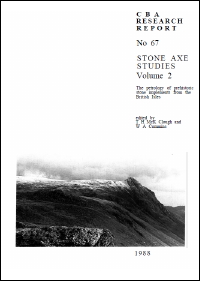CBA Research Reports
Council for British Archaeology, 2000. (updated 2020) https://doi.org/10.5284/1000332. How to cite using this DOI
Data copyright © Council for British Archaeology unless otherwise stated
This work is licensed under the ADS Terms of Use and Access.
Primary contact
Council for British Archaeology
92 Micklegate
York
YO1 6JX
UK
Tel: 01904 671417
Resource identifiers
- ADS Collection: 281
- DOI:https://doi.org/10.5284/1000332
- How to cite using this DOI
Stone Axe Studies Volume 2: The petrology of prehistoric stone implements from the British Isles
T H McK Clough and W A Cummins (editors)
CBA Research Report No 67 (1988)
ISBN 0 906780 69 1
Abstract

In this volume the Implement Petrology Committee of the Council for British Archaeology presents the results of examining over 7500 stone implements from the British Isles. These artefacts range in date from the earliest Neolithic - even earlier in some cases - to the Bronze Age; in type from polished stone axes to archers' wristguards; in quality from the finest jade to the coarsest roughout; and in composition from chalk to granite. They come from many known rock sources and places of manufacture, as far apart as the tip of Cornwall to the Northern Isles of Scotland, and from the random exploitation of glacial boulders far removed from their geographical origin. Together these implements comprise an extraordinarily extensive and varied cross-section of the stone tools and weapons made and used in Britain over a period of at least 3000 years.
Contents
- Title pages
- Contents (pp v-vi)
- List of illustrations (p vi)
- List of distribution maps (p vii)
- List of tables (p vii)
- Preface (p ix)
- Introduction to the regional reports: Prehistoric stone implements from the British Isles by T H McK Clough (pp 1-10)
- Addendum (p 11)
- 1 A method for taking petrological samples from stone implements by M B Fentin and R J A Travis (pp 12-13)
- 2 The petrological identification of stone implements from south-west England: sixth report by R V Davis, Hilary Howard and I F Smith (pp 14-20)
- 3 he petrological identification of stone implements from south-east England by A G Woodcock, D B Kelly and A R Woolley (pp 21-33)
- 4 The petrological identification of stone implements from London and Middlesex by T H McK Clough and W A Cummins (pp 34-36)
- 5 The petrological identification of stone implements from East Anglia by Barbara Green (pp 36-40)
- 6 The petrological identification of stone implements from the south-east Midlands by W A Cummins and W R G Moore (pp 41-44)
- 7 The petrological identification of stone implements from the east Midlands: third report by T H McK Clough and W A Cummins (pp 45-48)
- 8 The petrological identification of stone implements from the west Midlands: third report by F W Shotton (pp 49-51)
- 9 The petrological identification of stone implements from Yorkshire: second report by Patricia Phillips, W A Cummins and Laurence Keen (pp 52-59)
- 10 The petrological identification of stone implements from Lancashire and Cheshire by G R Coope, D J Robinson and F E S Roe (pp 60-66)
- 11 The petrological identification of stone implements from the Isle of Man by G R Coope and L S Garrad (pp 67-70)
- 12 The petrological identification of stone implements from Cumbria by C I Fell and R V Davis (pp 71-77)
- 13 The petrological identification of stone implements from north-east England by W A Cummins and A F Harding (pp 78-84)
- 14 The petrological identification of stone axes from Scotland by P R Ritchie and J G Scott (pp 85-91)
- 15 The petrological identification of stone battle-axes and axe-hammers from Scotland by M B Fenton (pp 92-132)
- 16 The petrological identification of stone implements from Wales by C H Houlder (pp 133-136)
- 17 The petrological identification of stone implements from Ireland by E L Francis, P J Francis and J Preston (pp 137-140)
- Lists of identifications (pp 141-264)
- Distribution map of grouped implements (pp 265-288)
- Index (pp 289-297)
Download report
| Stone Axe Studies Volume 2: The petrology of prehistoric stone implements from the British Isles (CBA Research Report 67) | 11 Mb |







